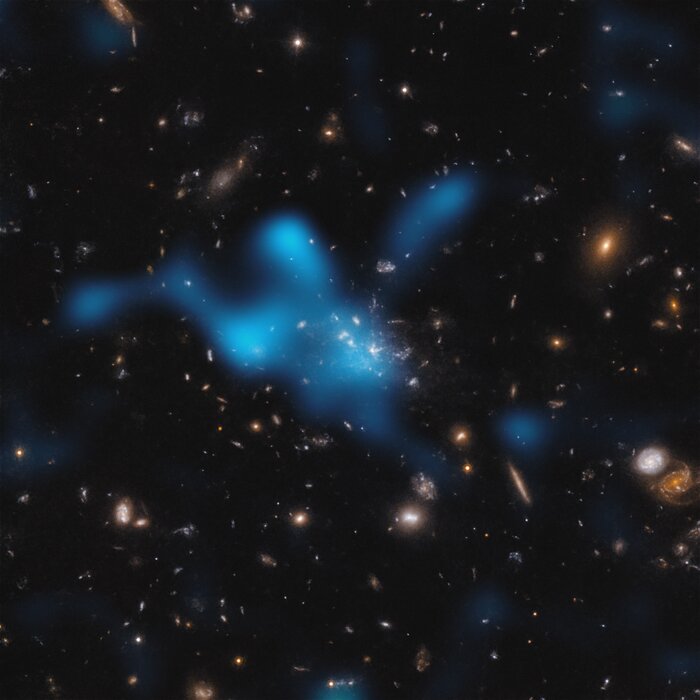The Sunyaev-Zeldovich effect in the Spiderweb protocluster
This image shows the protocluster around the Spiderweb galaxy (formally known as MRC 1138-262), seen at a time when the Universe was only 3 billion years old. Most of the mass in the protocluster does not reside in the galaxies that can be seen in the centre of the image, but in the gas known as the intracluster medium (ICM). The hot gas in the ICM is shown as an overlaid blue cloud.
The hot gas was detected with the Atacama Large Millimeter/submillimeter Array (ALMA), of which ESO is a partner. As light from the cosmic microwave background –– the relic radiation from the Big Bang –– travels through the ICM, it gains energy when it interacts with the electrons in the hot gas. This is known as the Sunyaev-Zeldovich effect. By studying this effect, astronomers can infer how much hot gas resides in the ICM, and show that the Spiderweb protocluster is in the process of becoming a massive cluster held together by its own gravity.
Credit:ESO/Di Mascolo et al.; HST: H. Ford
About the Image
| Id: | eso2304a |
| Type: | Observation |
| Release date: | 29 March 2023, 17:00 |
| Related releases: | eso2304 |
| Size: | 1500 x 1500 px |
About the Object
| Name: | Spiderweb Galaxy |
| Type: | Early Universe : Cosmology : Morphology : Large-Scale Structure |
| Constellation: | Hydra |
| Category: | Cosmology Galaxy Clusters |
Wallpapers
Coordinates
| Position (RA): | 11 40 48.50 |
| Position (Dec): | -26° 29' 8.62" |
| Field of view: | 1.00 x 1.00 arcminutes |
| Orientation: | North is -0.0° left of vertical |
Colours & filters
| Band | Wavelength | Telescope |
|---|---|---|
| Optical G | 475 nm | Hubble Space Telescope ACS |
| Millimeter CO | 2.7 mm | Atacama Large Millimeter/submillimeter Array Band 3 |
| Optical I | 814 nm | Hubble Space Telescope ACS |
| Optical G | 475 nm | Hubble Space Telescope ACS |
| Optical I | 814 nm | Hubble Space Telescope ACS |

